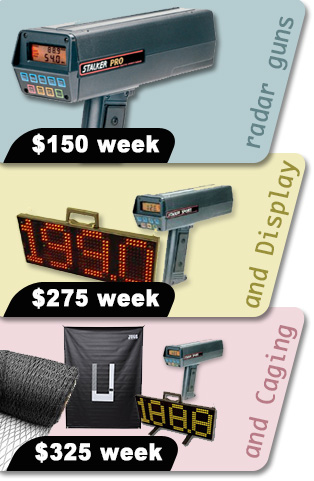
Mody Company Creative
Tom Mody
888-828-6639
tom@modycompany.com
56 West Main
Norwich NY 13815
607-336-6233 /ph
Shipping to You!
Racing & High Speed Applications
In all types of contested environments, the curiosity of speed holds as much for the participants as it does for the gallery. High speeds over 100 MPH are dependent on target acquisition time as are extremely low speeds. Target acquisition is how many times per second the radar signal reflects off the object back to the unit. As the unit moves toward or near the gun the radar can extrapolate the speed. A higher rate of reflection allows the unit to more easily lock in an accurate read.
Land Vehicles
Most of our general use units should be sufficient to time land vehicles. The same principals apply as listed in our roadside setup for traffic data. The best read would be a vehicle coming directly at you in as straight a line as possible. Of course the straightest line being standing in the middle of the road. However, since we'd like our equipment returned in one piece, that's not an option. Most vehicle units have at least a 3000 foot range to work with so try setting up on the roadside timing the vehicle as far down the road as possible. This will give you a straighter read, the closer the vehicle gets the more angle you create which may give you a slower speed. However, on busy highways with tightly positioned traffic, it will be hard to lock on the vehicle you intend to time. Timing the cars a bit closer will be the best option. Also try and use the units trigger mode to lock on a specific vehicle. Most units come with 2 modes, continuous and trigger. Continuous mode has the radar signal transmitting at all times so over a period of a few seconds it will update speeds. The trigger mode transmits only when the trigger is pressed and locks the first speed read. This should help keep reads from other external sources out of the equation.
Water Vehicles
Water creates a few problems for radar units. First would be the refraction of the radar signal. When the radar beam hits water it can split the radar signal off into different directions instead of bouncing it back to the radar. Also depending on the size of the boat, tail spray can create a stronger lock than the boat itself. Most newer radar guns operate in a K band signal. However, we do have Ka band units which are much better at combating beam refraction. These units also have the strongest target acquisition to get the very best lock on a water based vehicle.
Another common application for boats seems to be using radar guns to verify odometer accuracy. That should not be a problem except that most want the radar set up in the boat. Now a moving object can not time another moving object but aiming the radar on a large fixed object like a bridge can determine boat speed when the unit is in the moving boat.
Aircraft
Most aircraft applications are used for the model remote control industry. The 2 problems are remote frequency interference and angle errors. The remote frequency is generally not a problem with units that have filtering settings. The angle errors occur because accurate reads come when the timed object is in a straight line with the radar unit. That's common enough with the left right movement on a road, now adding the up and down angles of a plane and you have a tricky proposition. The radar unit will need to be positioned at an angle in line with the craft coming or going at near that same angle for an accurate read.







